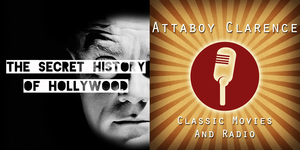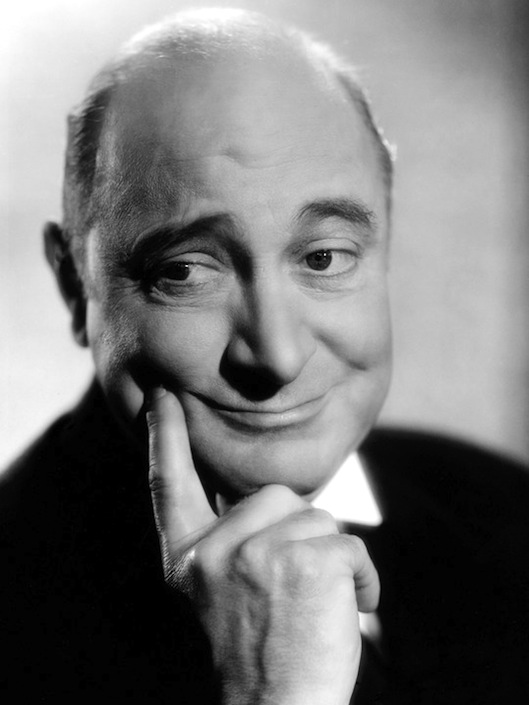If you see the name of Eric Blore in a movie's credits, you're guaranteed one thing: that you're going to laugh quite often. It's a heartening guarantee to go into a movie with, for sure, but such was Blore's comedic skill, that by the time he landed in sound movies, at the age of 46 in the first Fred Astaire/Ginger Rogers pairing, 'Flying Down To Rio', that he'd already become a favourite of movie-makers and actors.
With his swordfish nose and waspish, cut-glass British accent, Eric Blore was Hollywood's go-to man for irascible snob roles from 1933 onward. He'd starred as Lord Digby in the 1926 silent version of 'The Great Gatsby', starring Warner Baxter and William Powell, but his successes up to this point had been mainly on the stage.
It was in September of 1932 when he began rehearsals for 'Gay Divorce', a musical by Cole Porter, starring as the highly-strung waiter at a Brighton resort. It also starred Fred Astaire in his final Broadway role as the main romantic interest, Guy Holden, and Erik Rhodes as Tonetti, a professional lothario. When it was transferred to the screen in 1934, scheduled to be the second pairing of Astaire and Rogers, after the success of the previous year's 'Flying Down To Rio', Blore was kept in his role. He never looked back.
Indeed, no other actor co-starred more often in Astaire Rogers movies than Eric Blore. His roles were generally similar, that of a harassed, upper-class Englishman, either in a service capacity or of aristocratic standing.
His scene with Edward Everett-Horton in 'Shall We Dance' is probably the comedic highlight of the entire movie, his increasing frustration at Horton's inability to understand the name of the jail in which he is being held, building and building to a wonderful comic climax.
The same can be said for his terrific turn in Preston Sturges' 1941 comedy, 'The Lady Eve', where his debonair con-man, Sir Alfred McGlennan Keith spends a toe-curling scene shush-ing Henry Fonda, whilst spinning a frenetic web of lies regarding the parentage of Barbara Stanwyck.
He joined the 'Lone Wolf' franchise in 1940, playing the butler, Jamison, to Warren William's "Lone Wolf", Michael Lanyard, a role he played in a total of eleven movies, up until 1947. He also made a notable appearance in 1937's 'It's Love I'm After' as the butler, Digges, to Leslie Howard's Basil Underwood. His last appearance with Astaire, with whom he'd remained great friends, was in 1943's 'The Sky's The Limit', in which he delivered the immortal line, "If I were not such a gentleman's gentleman, I'd be such a cad's cad".
From the mid-1940's however, Hollywood's tastes had begun to change. The role of the sarcastic English butler of drawing-room and screwball comedies was on its way out, and Blore, who'd been typecast as such for much of his movie career, found work a little more difficult to come by.
His last notable performance was in Walt Disney's 1949 animation, 'The Wind in the Willows', giving voice to the gleefully irresponsible Mr Toad. Aside from two more film roles, a few years apart, he was finished with Hollywood.
Blore's legacy, though, still stands. He was regularly the funniest thing in any movie in which he starred, and the absolute antithesis of everything he outwardly represented: a beleaguered, contemptuous Brit, who ended most of his lines with a vexed harrumph, or the roll of his eyes.
In 1959, when he was 71 years old, The New Yorker printed an article by the noted British critic, Kenneth Tynan, who spoke of "the late Eric Blore". The news of his death was received with grief worldwide by all who had known him, and loved his movie roles.
No one was more aggrieved than Eric Blore, very much alive, who instantly demanded a retraction.
This was a first for The New Yorker, who, up until this point, had always been noted for their stringent fact-checking. It caused the magazine huge embarrassment, and made headlines around the world. Grudgingly, they had to admit their error, and promised to print a prominent retraction and apologise in their next issue.
On March 2nd, 1959, the night before the New Yorker retraction was to appear, when all copies of said magazine had been printed and distributed, ready for sale, Eric Blore died. The next day, newspapers all around the world carried news of his death, and of their sorrow at his passing.
All that is, except one.
The New Yorker, known until then as a leader in accuracy, and for their exacting correctness, instead carried a very prominent article retracting their former opinion that Eric Blore was dead, and apologising for any insult to his feelings that such a careless opinion might have caused.
Somewhere, Eric Blore was laughing.





